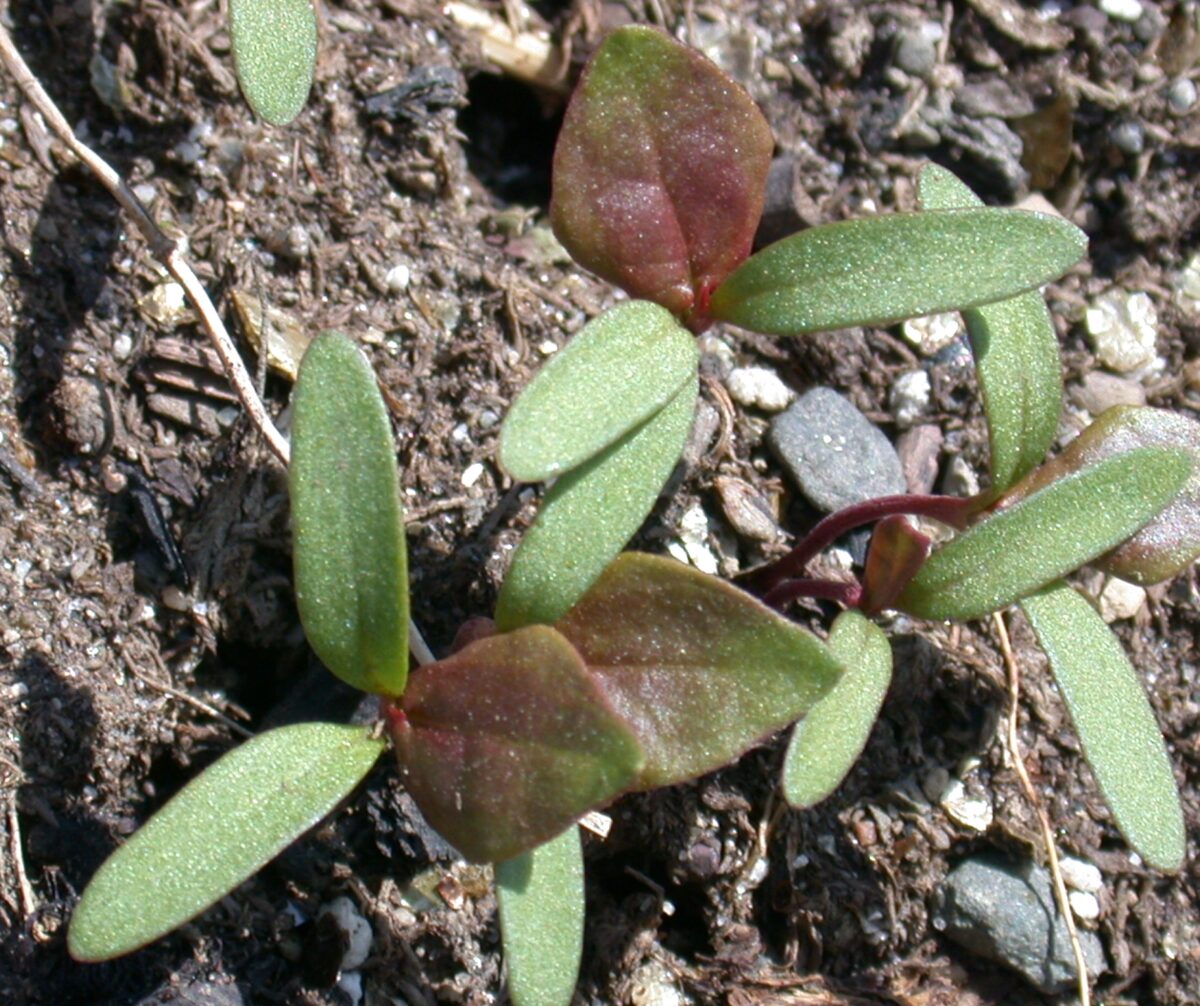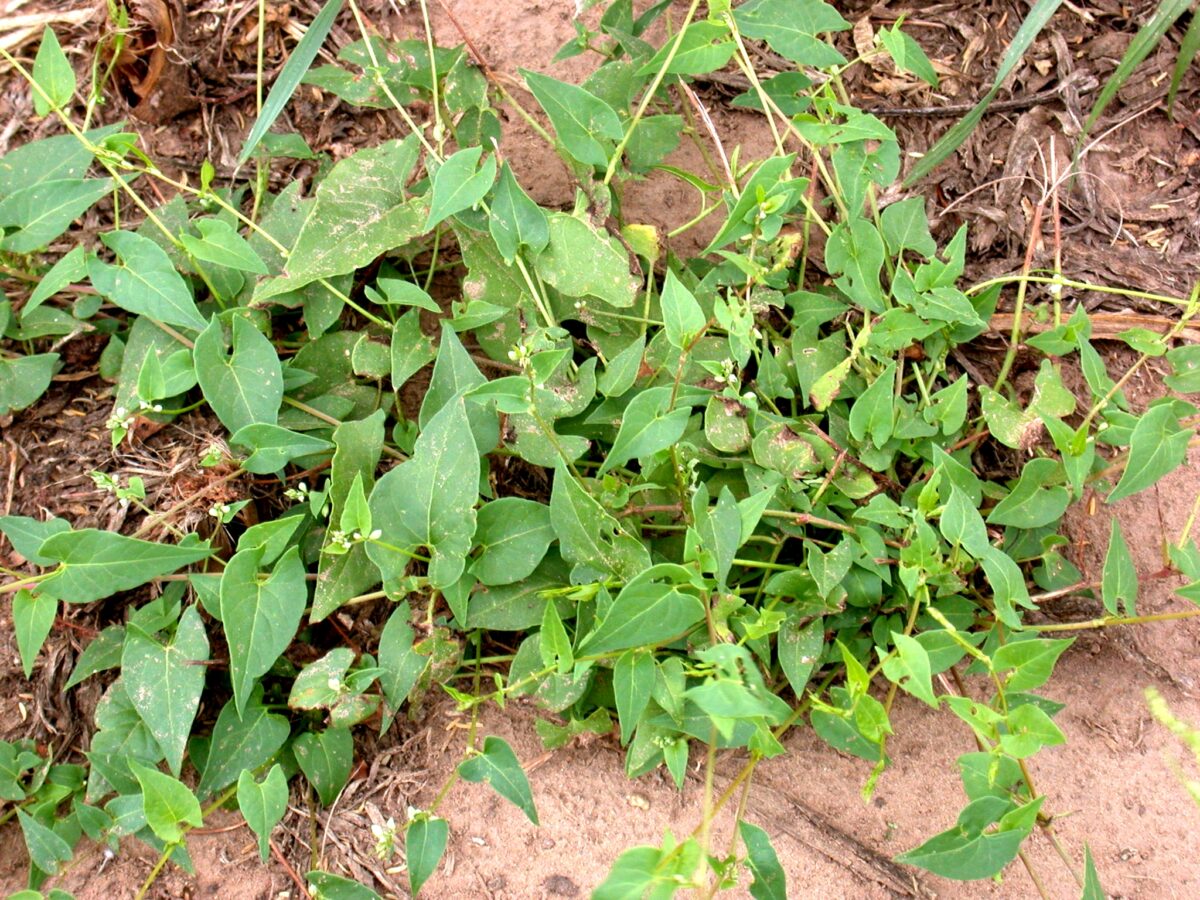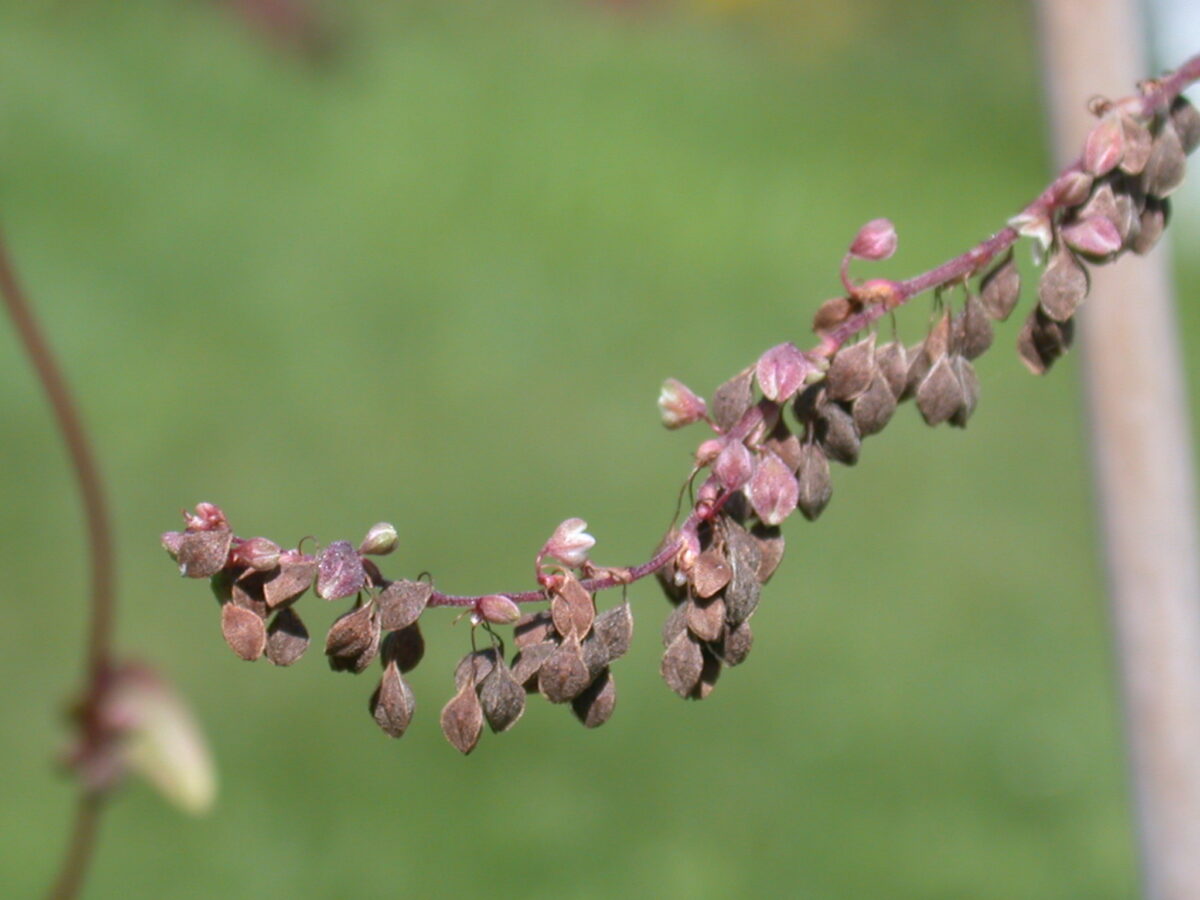Other common names: black bindweed, knot bindweed, bear bind, ivy bindweed, climbing bindweed, corn bind, climbing buckwheat, dullseed corn bind, climbing knotweed, devil’s bindweed, blackbird bindweed



Polygonum convolvulus L. = Fallopia convolvulus (L.) Á. Löve
Identification of Wild Buckwheat
Family: Buckwheat family, Polygonaceae
Habit: Twining summer annual herb
Description: Seedlings have two elongate, oval cotyledons that are 0.25–1.25 inch long by less than 0.25 inch wide, with round tips and a gritty, waxy surface. Cotyledons are often at a 120 degree angle from one another. The seedling stem is red-purple. Young leaves are arrow shaped with a tapered, pointed tip and basal, backwards pointing lobes. The first true leaves are blue-green on their upper surface and red on their lower surface. All true leaves have a thin, papery covering extending up the stem from the base of the leaf stalk (ocrea). Mature plants have smooth, weak, twining stems that branch near the base and reach up to 6.5 feet in length. Leaves are alternate, hairless, 0.75–2.5 inches long, arrow shaped with long pointed tips and backward pointing lobes and attached by long leaf stalks. Ocreae are 0.13–0.2 inch long sheaths that wrap the stem above leaf junctions. Leaves lower on the stem will be more triangular or heart shaped than younger, narrower leaves near the tip. The root is fibrous. Greenish-pink or greenish-white flowers are grouped into clusters of two to six on a long stem arising from axils of upper leaves or on tips of small branches. Individual flowers are 0.2 inch wide. Seeds are dull, black, sharply three sided and may be covered by the papery, brown remnants of flower parts.
Similar species: Tartary buckwheat [Fagopyrum tartaricum (L.) Gaertn.] and domestic buckwheat (Fagopyrum esculentum Moench) do not twine onto other plants and have more compact inflorescences and larger seeds. Hedge bindweed [Calystegia sepium (L.) R. Br.] and field bindweed (Convolvulus arvensis L.) resemble wild buckwheat, but both are perennials with thick, spreading roots. Leaves of wild buckwheat are more tapered and pointed at the tip than leaves of either of the bindweeds. The lobes of hedge bindweed leaves are squarish in outline when laid flat, whereas wild buckwheat and field bindweed leaf-lobes are pointed. The flowers of both bindweeds are large and either white or pink, and they occur singly. This is unlike wild buckwheat flowers, which are small, green and clustered. Bindweeds lack ocrea.
Management of Wild Buckwheat
Wild buckwheat is a severe weed in spring sown cereal grains and a problem in many other field and vegetable crops. In cereal grains, management during preceding crops in the rotation is critical since options are limited in spring grains. A vigorous winter grain crop will tend to suppress the seedlings. Properly timed cultivation can control the weed in row crops like corn and soybeans. If this species is causing severe problems in your spring grains and you rotate with corn, cleaning up plants in the corn rows with a flame weeder may be worthwhile. Including later planted crops like soybeans, dry beans and summer vegetables in the rotation allows a period in the spring for a tilled fallow that will reduce the seed bank going into a subsequent cereal grain the next year. If time permits, work the soil to a depth of about 3 inches at about one-week intervals to ensure that all seeds in the surface soil get exposed to enough warmth to prompt germination.
For this species, effectiveness of tine weeding (harrowing) and rotary hoeing are limited in both grains and row crops because many of the seedlings arise from depths below the seeding depth of the crop. Some seedlings will be buried by a tine weeder, however, so if you can do the operation soon after the first flush of seedlings emerge it can still provide some control. A dense planting of grains helps reduce losses in fields infested with wild buckwheat. Although the species climbs, it does not begin climbing until about a month after emergence. Rapid canopy closure and root proliferation from a dense crop sowing can help suppress this species. Slightly lower than optimal nitrogen fertility suppresses wild buckwheat more than it does grain crops.
Cultivation in row crops should be aimed at uprooting plants while they are small and burying newly emerged seedlings in the row. Rerooting becomes an increasing problem as the wild buckwheat grows. Consequently, tools that cut are more effective against wild buckwheat than are those that dig. If this species is a problem, consider investing in an implement that can work close to the crop when it is still small.
If you do not already have wild buckwheat, inspect any uncertified grain and cover crop seed for the characteristic three-sided seeds of wild buckwheat before you sow it.
Ecology of Wild Buckwheat
Origin and distribution: Wild buckwheat originated in Europe but is now found throughout the world’s temperate regions and as far north as Greenland and Alaska. The species occurs throughout the United States and Canada.
Seed weight: 4.7–7 mg.
Dormancy and germination: Seeds are dormant when shed from the parent plant, and very few will germinate until subjected to a prolonged period of cold, wet conditions. Dormancy results from a hard seed coat, which, when scarified, allows germination. A cold, moist period of at least two months with daily alternating temperatures between 36–50°F will break dormancy and induce maximum germination similar to mechanical seed coat removal. Non-dormant seeds germinate well at 68–77°F. Most seeds enter secondary dormancy during hot, dry summer weather and then require a second period of cold, wet conditions before germination is again possible. Light and nitrate do not affect germination. In the field, germination and emergence is slow, requiring from nine to 31 days.
Seed longevity: Seed longevity may vary between populations. Most viable seeds germinate the year after production, but some may survive for several decades deep in cool, moist soil. In soil stirred four times per year, the number of wild buckwheat seeds declined by 32–50% per year, whereas in undisturbed soil they declined at 20–25% per year. In Alaska, annual mortality of buried seeds was computed at 52% and at 46% in France. Based on these studies, the seed bank is moderately persistent but susceptible to management.
Season of emergence: Most emergence occurs in early spring with some emergence continuing into summer. Maximum emergence occurs at soil temperatures less than 60°F.
Emergence depth: Most seedlings emerge from anywhere in the top 2 inches of soil, but occasional seedlings emerge from as deep as 5 inches or more. Emergence was often best from 0.4–1.6 inch depths rather than from the soil surface or deeper.
Photosynthetic pathway: C3
Sensitivity to frost: Wild buckwheat is killed by hard frost.
Drought tolerance: This species absorbs soil moisture efficiently and competes well with crops under dry soil conditions.
Mycorrhiza: Wild buckwheat is not mycorrhizal.
Response to fertility: The growth response of wild buckwheat to N is similar to wheat. Both species continue to increase in size up to application rates beyond 214 pounds per acre of N, but the incremental increase with greater N is moderate. The species is highly responsive to P application rates up to 164 pounds per acre of P2O5. Increasing fertility tends to favor wild buckwheat more than field crops like wheat and flax.
Soil physical requirements: Wild buckwheat occurs on a wide range of soil types. But generally, it is best adapted to heavier soil with good moisture holding capacity. Soil compaction does not affect seed germination.
Response to shade: The vining habit of wild buckwheat potentially allows it to avoid shade by climbing up competing crop plants. However, the species does not begin twining onto crops until about a month after emergence, and it can be suppressed by shade if the crop canopy closes quickly.
Sensitivity to disturbance: Since many individuals typically emerge from relatively deep in the soil, shallow disturbance with a tine weeder or rotary hoe leaves many individuals unaffected. In contrast, tools that cut seedlings and young plants at or just below the soil surface kill the weed. The fibrous root system holds soil and helps larger plants reroot after cultivation.
Time from emergence to reproduction: On average, wild buckwheat begins flowering at six to eight weeks after emergence, and the first seeds mature about three weeks later in Saskatchewan. In Wisconsin, 12 weeks were required between emergence and flower initiation. Maturation is faster in warm weather, but the plants are less vigorous. Because of the indeterminant flowering habit of wild buckwheat, flowers, immature seeds and mature seeds may be found on the same plant. Up to half of the seeds of late emerging plants may not reach maturity by the first killing frost.
Pollination: Wild buckwheat primarily self-pollinates, and seed set often occurs even though the flowers remain closed. Even open flowers do not attract pollinating insects.
Reproduction: Wild buckwheat reaches maturity midseason and continues flowering and releasing seeds for most of the growing season. Large, old plants often lose most of their leaves but still continue maturing seeds. Large plants can produce as many as 12,000–30,000 seeds.
Dispersal: Wild buckwheat spread throughout the world primarily in contaminated seed grain. The seeds float and can spread in surface irrigation water. They also move about on tires, tillage machinery and combines. Wild buckwheat seeds can survive for several months in silage and can survive rumen digestion for 24 hours. Thus, the species probably disperses in manure.
Common natural enemies: The beetle Gastrophysa polygoni eats the foliage, and larvae of the fly Pegomyia setaria mine the leaves.
Palatability: The seeds are edible but low in oil and protein. The stems and leaves have low forage value for livestock.
Summary table of Wild Buckwheat Characteristics
| Wild buckwheat | ||||||||
|---|---|---|---|---|---|---|---|---|
| Growth habit | Seed weight (mg) | Seed dormancy at shedding | Factors breaking dormancy | Optimum temperature for germination (F) | Seed mortality in untilled soil (%/year) | Seed mortality in tilled soil (%/year) | Typical emergence season | Optimum emergence depth (inches) |
| twining | 4.7–7 | Yes | scd, cms, at | 68–77 | 20–52 | 32–50 | early spring | 0.4–1.6 |
| Photosynthesis type | Frost tolerance | Drought tolerance | Mycorrhiza | Response to nutrients | Emergence to flowering (weeks) | Flowering to viable seed (weeks) | Pollination | Typical & high seed production (seeds per plant) |
| C3 | low | moderate | no | high | 6–12 | 3 | self | na & 20,000 |
Table Key
General: The designation “–” signifies that data is not available or the category is not applicable.
Growth habit: A two-word description; the first word indicates relative height (tall, medium, short, prostrate) and second word indicates degree of branching (erect, branching, vining).
Seed weight: Range of reported values in units of “mg per seed.”
Seed dormancy at shedding: “Yes” if most seeds are dormant when shed, “Variable” if dormancy is highly variable, “No” if most seeds are not dormant.
Factors breaking dormancy: The principle factors that are reported to break dormancy and facilitate germination. The order of listing does not imply order of importance. Abbreviations are:
scd = seed coat deterioration
cms = a period subjected to cold, moist soil conditions
wst = warm soil temperatures
li = light
at = alternating day-night temperatures
ni = nitrates
Optimum temperature range for germination: Temperature (Fahrenheit) range that provides for optimum germination of non-dormant seeds. Germination at lower percentages can occur outside of this range. The dash refers to temperature range, and the slash refers to alternating day/night temperature amplitudes.
Seed mortality in untilled soil: Range of mortality estimates (percentage of seed mortality in one year) for buried seeds in untilled soil. Values were chosen where possible for seeds placed at depths below the emergence depth for the species and left undisturbed until assessment. Mortality primarily represents seed deterioration in soil.
Seed mortality in tilled soil: Range of mortality estimates (percentage of seed mortality in one year) for seeds in tilled soil. Values were chosen for seeds placed within the tillage depth and subjected to at least annual tillage events. Seed losses are the result of dormancy-breaking cues induced by tillage, germination and deterioration of un-germinated seeds.
Typical emergence season: Time of year when most emergence occurs in the typical regions of occurrence for each weed. Some emergence may occur outside of this range.
Optimum emergence depth: Soil depths (in inches below the soil surface) from which most seedlings emerge. Lower rates of emergence usually will occur at depths just above or just below this range.
Photosynthesis type: Codes “C3” or “C4” refer to the metabolic pathway for fixing carbon dioxide during photosynthesis. Generally, C3 plants function better in cooler seasons or environments and C4 plants function better in warmer seasons or environments.
Frost tolerance: Relative tolerance of plants to freezing temperatures (high, moderate, low).
Drought tolerance: Relative tolerance of plants to drought (high, moderate, low).
Mycorrhiza: Presence of mycorrhizal fungi. “Yes” if present; “no” if documented not to be present, “unclear” if there are reports of both presence and absence; “variable” if the weed can function either with or without, depending on the soil environment.
Response to nutrients: Relative plant growth response to the nutrient content of soil, primarily N, P, K (high, moderate, low).
Emergence to flowering: Length of time (weeks) after emergence for plants to begin flowering given typical emergence in the region of occurrence. For species emerging in fall, “emergence to flowering” means time from resumption of growth in spring to first flowering.
Flowering to viable seed: Length of time (weeks) after flowering for seeds to become viable.
Pollination: “Self” refers to species that exclusively self-pollinate, “cross” refers to species that exclusively cross-pollinate, “self, can cross” refer to species that primarily self-pollinate, but also cross-pollinate at a low rate, and “both” refers to species that both self-pollinate and cross-pollinate at relatively similar rates.
Typical and high seed production potential: The first value is seed production (seeds per plant) under typical conditions with crop and weed competition. The second value, high seed production, refers to conditions of low density without crop competition. Numbers are rounded off to a magnitude that is representative of often highly variable reported values.
Further Reading
Forsberg, D.E. and K.F. Best. 1964. The emergence and plant development of wild buckwheat (Polygonum convolvulus). Canadian Journal of Plant Science 44: 100–103.
Hume, L., J. Martinez and K.F. Best. 1983. The biology of Canadian weeds. 60. Polygonum convolvulus L. Canadian Journal of Plant Science 63: 959–971.
Mertens, S.K. and J. Jansen. 2002. Weed seed production, crop planting patterns, and mechanical weeding in wheat. Weed Science 50: 748–756.

